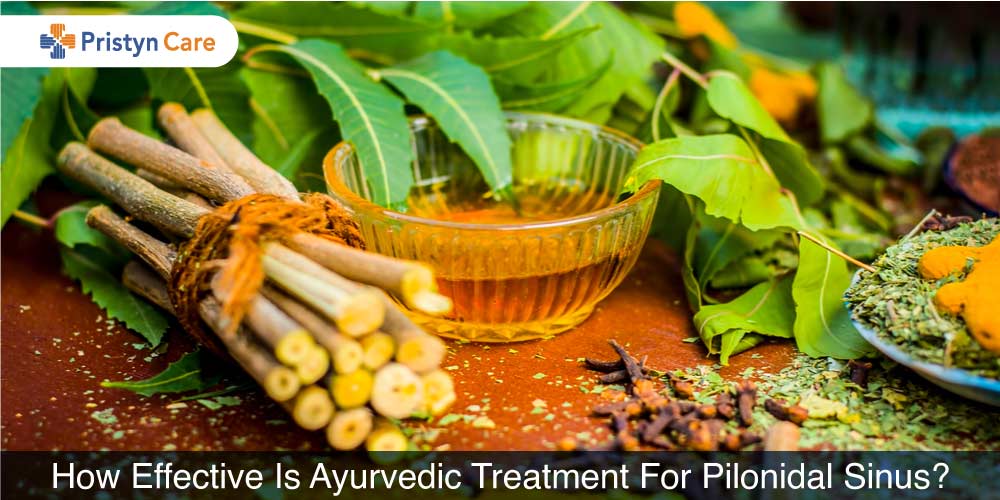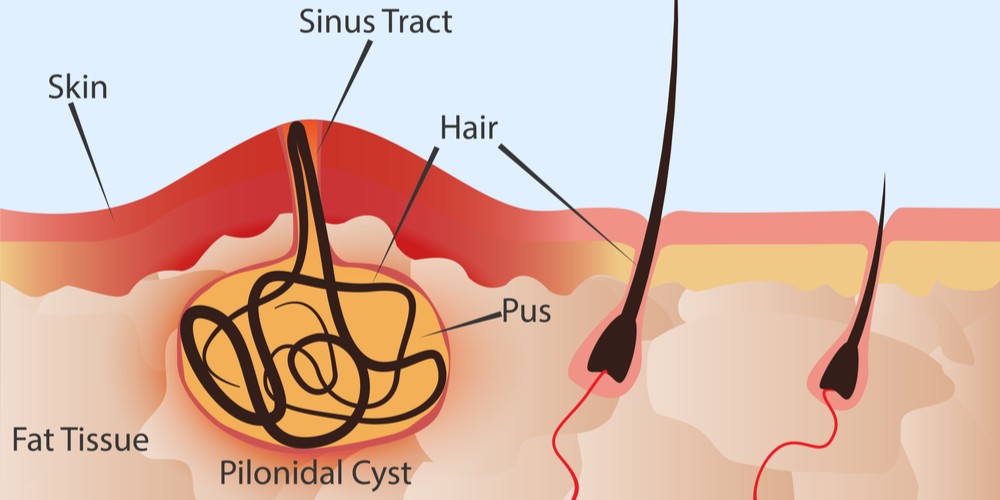
In pilonidal sinus, a small hole or channel develops in the natal cleft (between the buttocks). The condition of pilonidal grows to be quite painful with time. The condition is also known as “Jeep Bottoms” or “Barber’s Disease”.
There can be various reasons for the formation of this abnormal channel. Excessive and coarse hair is one of the major causes of pilonidal sinus. When hair follicles enter the skin pits, an immune response is launched leading to the formation of a cyst around the hair. Hormonal changes also play a pivotal role in the condition. Also, friction and pressure-generating activities can increase the chances of the hair follicles entering the skin.
Furthermore, there are many factors that contribute to increasing the risks of pilonidal sinus. These include previous injuries, hairy and deep natal cleft, obesity, sedentary jobs, and a family history of the condition.
Any of the aforementioned causes can lead to the development of pilonidal sinus.

Table of Contents
Let’s quickly take a look at the troubles pilonidal sinus causes once it gets developed.
The condition starts with the formation of a small dimple like structure between the buttocks. At the initial stages, pilonidal sinus does not have any symptoms and does not cause much discomfort. However, over time, the condition starts to worsen and symptoms start surfacing. The dimple-like structure starts getting filled with pus and fluid and the pilonidal cyst is formed at the bottom of the tailbone. This is a troublesome condition and causes severe pain and discomfort.
Adding to the misery, these pilonidal cysts are prone to get infected. When this happens, a discharge of blood and pus can be seen from the cyst. This discharge is accompanied by a foul odor. Pilonidal sinus can hinder your normal routine life. You may experience severe pain in routine activities like sitting and wearing clothes. (Also Read: How to care when you are suffering from Pilonidal Sinus)

Now that you’ve seen the causes and complications of pilonidal sinus, you must be wondering how you can get rid of the problem and what treatment you can opt for.
Treatment for Pilonidal Sinus
You will be relieved to know that pilonidal sinus is completely curable. There are a variety of medicines that can provide temporary and symptomatic relief from pilonidal sinus. According to conventional medicine, the only permanent treatment for pilonidal sinus is surgery. However, the majority of the people are skeptical about surgical treatments for pilonidal sinus and want to opt for effective alternatives. (Also Read: Limberg flap for pilonidal sinus)
If you too are unsure about surgery and want to avoid it, you will be glad to know that pilonidal sinus can be treated through Ayurveda also. Ayurveda uses natural herbs and methods for the treatment and there is no risk of side-effects. Let’s now get an insight into how Ayurvedic treatment for pilonidal sinus works.
Ayurvedic Treatment of Pilonidal Sinus
In Ayurvedic terms, pilonidal sinus is known as Nadi Vrana. Ayurvedic treatment for pilonidal sinus involves a procedure called the Kshar Sutra. The procedure uses a specially prepared thread for treating pilonidal sinus.
Kshar Sutra for pilonidal sinus
The first step of the procedure is to prepare the Kshar Sutra. For this, a surgical linen thread gauge number 20 is coated with Snuhi latex 11 times, Snuhi latex and Apamarga Kshara 7 times and Snuhi latex and Haridra Churna 3 times. The ayurvedic doctor places this Kshar Sutra inside the pilonidal sinus. This is done by passing the thread through the external opening of the skin and then tying its ends.
The doctor replaces the thread with a new one every 7 days. This entire therapy of Kshar Sutra takes 4-8 weeks to complete depending upon the severity of pilonidal sinus. Eventually, the pilonidal ainua heals and the microbial infections come under control. Also, the unhealthy tissues are removed, and the drainage of pus ensure faster healing of the pilonidal sinus.
However, you should remember that Kshar Sutra is not advised if you are pregnant, or if you have hepatitis, leprosy, or carcinoma in the rectum.
Recovery after Kshar Sutra
After the complete procedure is over, you will recover in about 3-5 days and may experience a very mild post-procedural pain. To ensure faster recovery after kshar sutra, you should avoid spicy, greasy, and fast foods until you completely recover. You should increase the intake of fruits and green vegetables. Consuming plenty of fluids also helps in hastening the healing process of the pilonidal sinus. After the treatment, your ayurvedic specialist may recommend you some herbs to aid the recovery process. The Ayurveda experts also recommend a sitz bath for 3 weeks after the procedure.

There are no side-effects or risks associated with the Kshar Sutra treatment. The therapy is absolutely safe and is also very cost-effective. Furthermore, the chances of recurrence of pilonidal sinus after Kshar Sutra treatment are lesser than other medications.
You must have now understood that the Kshar Sutra technique in Ayurveda can be a very effective non-surgical treatment for pilonidal sinus. The treatment provides relief in most of the cases. However, if in your case the treatment is not helpful or if the condition keeps on reappearing, consult a specialist doctor.
What to do if pilonidal sinus recurs?
If your doctor suggests undergoing surgical treatment, do not fret as nowadays, the modern technique of laser surgery is available. The laser surgery is a minimally invasive procedure that takes only about 30 minutes to complete. Laser surgery is absolutely safe and there is no risk of postoperative infections or complications. Also, it is a permanent treatment that ensures that the pilonidal sinus will not occur in the area ever again.
Laser surgery for pilonidal sinus is available at Pristyn Care. If you requi laser surgery or if you have any doubts about the procedure, contact us today. Our medical coordinators will guide you through the procedure and after laser surgery, you will get rid of pilonidal sinus once and for all.
Also Read:







